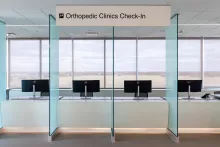Torn Meniscus
- For all other requests:
- 1-800-777-8442
If you’ve torn your meniscus, you’re not alone. Meniscus tears are a common knee injury among people of all ages.
While a torn meniscus is treatable, making a full recovery—and avoiding complications—requires expert care.
Fortunately, orthopedic specialists with University of Iowa Health Care can help.
We have the experience it takes to distinguish meniscus tears from other injuries that cause knee pain and instability. And we offer the treatments you need to heal, with options ranging from nonsurgical therapies to advanced surgical procedures.
In fact, we’re one of the few medical centers in Iowa that offers meniscus transplants for people with severe meniscus damage.
Torn meniscus symptoms and diagnosis
Your meniscus is a C-shaped piece of tissue (cartilage) that sits inside your knee joint. Each knee has two menisci, located on the inside and outside of the joint. They help cushion the area where your thigh bone and shin bone meet.
Even though this tissue is flexible, it’s possible to tear your meniscus during certain movements. This includes sudden twisting motions where you may over-rotate your knee.
Meniscus tears are common in athletes and people with physically demanding jobs. But they also affect older people whose cartilage has been weakened or worn away by osteoarthritis.
Symptoms of a torn meniscus
Meniscus injury symptoms vary based on the severity of the tear. You may feel mild pain without any instability. Or your knee may immediately give out.
The most common signs of a torn meniscus include:
-
A locking or catching sensation when you bend your knee
-
Feeling a “pop” in your knee at the moment of injury
-
Knee instability
-
Knee pain
-
Knee swelling
-
Stiffness that makes it hard to bend your knee or straighten your leg
Diagnosing a meniscus tear
If you’ve injured your knee, you can count on UI Health Care for a prompt diagnosis. To confirm whether you have a torn meniscus, we’ll use one or more of the following tests:
-
A physical examination to assess your knee stability and flexibility, and to look for signs of swelling.
-
Imaging tests, such as an X-ray or MRI, to see the severity of your tear. An MRI can also show us whether you’ve injured other knee tissue. For example, some people with a torn meniscus also have an anterior cruciate ligament (ACL) tear.
-
A knee arthroscopy to examine your menisci up close. With knee arthroscopy, we guide a tiny camera into your knee through a small incision.
Because our orthopedic specialists have treated many people with meniscus tears, they’re skilled at making treatment recommendations. Together, you’ll decide which treatment options are best suited to your medical needs and personal goals.
Treatments for a torn meniscus
Small meniscus tears may heal on their own with rest and rehabilitation. Larger tears may require surgery.
No matter which treatment you receive, our goal is to:
-
Reduce or eliminate your knee pain
-
Improve your knee stability
-
Improve your mobility, allowing you to take part in your favorite activities
-
Slow or stop the progression of arthritis
Nonsurgical treatments for meniscus tears
Not everyone with a torn meniscus needs surgery. If you have a mild tear and your knee joint is stable, nonsurgical therapy may be all you need.
These treatments include:
Your provider may recommend avoiding activities that increase your risk of further knee problems.
You can keep your knee stable, and lower your risk of re-injury, by wearing a knee brace during certain activities.
Our physical therapists can teach you exercises that improve your knee strength, flexibility, and range of motion. We can also help you strengthen the surrounding leg muscles that support your knee.
We can inject certain types of human cells into your knee to help decrease knee pain associated with meniscus tears. These therapies include platelet-rich plasma (PRP) and bone marrow aspirate concentrate (BMAC).
Meniscus surgery
For some people with a torn meniscus, surgery is the best (or only) treatment option.
UI Health Care offers several types of meniscus surgery. The type you’ll need is based on factors like your age, the severity of your tear, and your activity level.
Our areas of expertise include:
-
Meniscus repair: Your surgeon stitches the torn pieces of cartilage back together.
-
Meniscectomy: Your surgeon trims and removes damaged areas of cartilage (also known as debridement). They aim to remove only the injured portion of the meniscus (partial meniscectomy) while preserving remaining functional areas of the meniscus.
-
Meniscus transplant: Your surgeon replaces your severely torn or missing meniscus with cartilage from a tissue donor. This option, also known as meniscus replacement, is typically reserved for people under age 40 who have little or no arthritis in their knee.
We perform most meniscus surgeries with knee arthroscopy. This is the same minimally invasive technique we sometimes use to diagnose a torn meniscus.
With this approach, we only need to make a couple of small incisions around the joint. We use a tiny camera and miniature surgical tools to repair your meniscus through those incisions.
Our Care Team


- Orthopedics and Rehabilitation











- Orthopedics and Rehabilitation



Need treatment for a torn meniscus?
Locations and Offices



